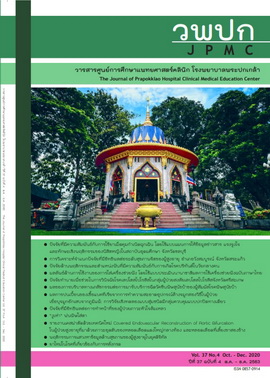Bacterial Contamination Results by Two Cleaning Techniques of Nasal Irrigation Bottle in Allergic Rhinitis Patients: Single-blinded, Randomized Controlled Study
Main Article Content
Abstract
Background: Nasal irrigation in patients with allergic rhinitis helps to control the symptoms and improves the quality of life. In Thailand, there is no information about bacterial contamination rates in nasal irrigation bottles for these patients, and there are still no data concerning cleaning methods of nasal irrigation bottles to reduce bacterial contamination.
Objectives: To compare bacterial contamination rates in the nasal irrigation bottles between cleaning methods of tap water, or 0.9% saline solution, and to investigate the relationship between contamination results and symptoms of acute rhinosinusitis.
Materials and methods: This single-blinded randomized controlled trial was conducted in 69 patients with allergic rhinitis, who had used a nasal irrigation bottle at least once a day at the Department of Otolaryngology, Burapha University Hospital, in May 2020. The patients were divided into 2 groups according to their bottle cleaning method, namely tap water or 0.9% saline solution. After 4 weeks of the bottle usage, the bacterial culture of the bottle was examined and the patients were asked about the symptoms of acute rhinosinusitis in the follow-up period.
Results: The contamination rates of the groups for bottle cleaning with tap water and 0.9% saline solution were 61.1% and 57.6% respectively, and the most common microorganism was Pseudomonas aeruginosa. The contamination rates of both groups were not statistically significantly different (p = 0.77) and the relationship between the contamination rate and the symptoms of acute rhinosinusitis was not statistically significant (p = 0.79).
Conclusion: Bacterial contamination rates between the groups of nasal irrigation bottle cleaning with tap water and 0.9% saline solution were not statistically significantly different and the bottle contamination rate was not statistically significantly associated with the symptoms of acute rhinosinusitis.
Article Details
References
Scadding GK, Kariyawasam HH, Scadding G, Mirakian R, Buckley RJ, Dixon T, et al. BSACI guideline for the diagnosis and management of allergic and non-allergic rhinitis (Revised Edition 2017; First edition 2007). Clin Exp Allergy 2017;47:856-89.
Hermelingmeier KE, Weber RK, Hellmich M, Heubach CP, Mösges R. Nasal irrigation as an adjunctive treatment in allergic rhinitis: a systematic review and meta-analysis. Am J Rhinol Allergy 2012;26(5):e119-25.
Phattanajindakul C. Fluticasone furoate. J Prapokklao Hosp Clin Med Educat Center 2013;30:168-72.
Jung M, Lee JY, Ryu G, Lee KE, Hong SD, Choi J, et al. Beneficial effect of nasal saline irrigation in children with allergic rhinitis and asthma: A randomized clinical trial. Asian Pac J Allergy Immunol [Internet]. 2019 [cited 2020 Jan 5]; Available form: http://apjai-journal.org/wp-content/uploads/2019/04/AP-070918-0403.pdf
Head K, Snidvongs K, Glew S, Scadding G, Schilder AG, Philpott C, et al. Saline irrigation for allergic rhinitis. Cochrane Database Syst Rev [Internet] 2018 [cited 2020 Jan 5]. Available form: https://www-ncbi-nlm-nih-gov.cuml1.md.chula.ac.th/pmc/articles/PMC6513421/pdf/CD012597.pdf
Nguyen SA, Camilon MP, Schlosser RJ. Identification of microbial contaminants in sinus rinse squeeze bottles used by allergic rhinitis patients. World J Otorhinolaryngol Head Neck Surg 2019;5:26-9.
Keen M, Foreman A, Wormald PJ. The clinical significance of nasal irrigation bottle contamination. Laryngoscope 2010;120:2110-4.
Welch KC, Cohen MB, Doghramji LL, Cohen NA, Chandra RK, Palmer JN, et al. Clinical correlation between irrigation bottle contamination and clinical outcomes in post-functional endoscopic sinus surgery patients. Am J Rhinol Allergy 2009;23:401-4.
Torretta S, Mattina R, Talloru F, Sala G, Cornelli S, Bezze E, et al. Bacterial contamination of saline nasal irrigations in children: An original research. Am J Infect Control 2019;47:95-7
Lee JM, Nayak JV, Doghramji LL, Welch KC, Chiu AG. Assessing the risk of irrigation bottle and fluid contamination after endoscopic sinus surgery. Am J Rhinol Allergy 2010;24:197-9.
Williams GB, Ross LL, Chandra RK. Are bulb syringe irrigators a potential source of bacterial contamination in chronic rhinosinusitis? Am J Rhinol 2008;22:399-401.
Satdhabudha A, Utispan K, Monthanapisut P, Poachanukoon O. A randomized controlled study comparing the efficacy of nasal saline irrigation devices in children with acute rhinosinusitis. Asian Pac J Allergy Immunol 2017;35:102-7.
Chow SC, Shao J , Wang H. Sample size calculations in clinical research. 2nd ed. New York : Chapman & Hall/CRC; 2008.
Fokkens WJ, Lund VJ, Hopkins C, Hellings PW, Kern R, Reitsma S, et al. Acute rhinosinusitis including common cold-and recurrent ARS in adults and children. and Rhinology 2020;58(Suppl 29):53-67.
Morong S, Lee JM. Microwave disinfection: assessing the risks of irrigation bottle and fluid contamination. Am J Rhinol Allergy 2012; 26:398-400.
Tuntaraworasin J, Kirtsreesakul V, Thamjarungwong B. Endoscopically middle meatal swab culture in normal subject [Internet].2008[cited 2020 May 15].Available from: http://rcot.org/download/rcot-Resident2008_a17.pdf

